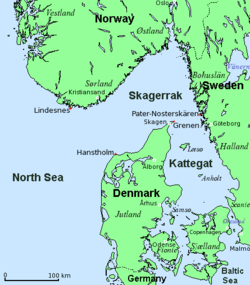Skagerrak

The Skagerrak is a strait running between Norway and the southwest coast of Sweden and the Jutland peninsula of Denmark, connecting the North Sea and the Kattegat sea area, which leads to the Baltic Sea.
Contents |
Name
The names for both Skagerrak and Kattegat are of Dutch origin. Skagerrak is derived from the Dutch word for Skagen, the northernmost town of Jutland. The syllable "rak" means a straight waterway.[1][2] The ultimate source of this syllable is the Proto-Indo-European root *reg-, "straight". No evidence suggests a connection to the modern Danish word rak (meaning rabble or riff-raff). If the name is derived from non-Germanic languages, ie. Celtic (Goidelic), the most likely etymological link would be to 'sgag' meaning 'split' and 'loch' meaning 'lake' (Latin 'lacus'). This is also suggested by similar '-ak', '-lok' and '-log' limnic names across Skagerrak in Telemark, Norway.
According to Den Store Danske Encyklopædi and Politikens Nydansk Ordbog, the name Kattegat derives from the Dutch words Kat (cat) and Gat (hole). It refers to late medieval navigation, where captains compared this region to a hole so narrow that even a cat would have difficulty creeping through due to the many reefs and shallow waters.[3][4] At one point, the passable waters are a mere 3.84 kilometers (2.38 miles) wide. An older name for both the Skagerrak and Kattegat was the Norwegian Sea or Jutland Sea. Knýtlinga saga mentions the name Jótlandshaf for both waters.
Geography

The Skagerrak is roughly triangular in shape, measuring 240 kilometers (149 mi) in length, and between 80 km (50 mi) and 140 km (87 mi) in width. It deepens toward the Norwegian coast, reaching over 700 metres at the Norwegian Trench. Some ports along the Skagerrak are Oslo and Kristiansand in Norway and Uddevalla and Strömstad in Sweden.
The Skagerrak has a salinity of 30 practical salinity units. The volume available to biomass is about 3,600 square kilometers (1,390.0 sq mi), including a wide variety of habitats from the sandbanks to Sweden and Denmark to the deeps of the Norwegian trench.
Extents
The International Hydrographic Organization defines the limits of the Skagerrak as follows:[5]
On the West. A line joining Hanstholm () and the Naze (Lindesnes, ).
On the Southeast. The Northern limit of the Kattegat [A line joining Skagen (The Skaw, North Point of Denmark) and Paternoster Skær () and thence Northeastward through the shoals to Tjörn Island].
History
In both world wars, the Skagerrak was strategically very important for Germany. One of the biggest sea battles of World War I, the Battle of Jutland, also known as the Battle of the Skagerrak, took place there May 31 to June 1, 1916. The importance of controlling this waterway, the only natural access to the Baltic, provided the motivation for the German invasion of Denmark and Norway during World War II.
In November 1850, it was an important part of the route of the refugees Carl Schurz and Gottfried Kinkel when they fled from Berlin to Edinburgh after Kinkel's escape from prison.[6]
Biology
The Skagerrak provides a habitat for approximately 2000 marine species, many of them adapted to its waters. For example, a variety of Atlantic cod called the Skagerrak cod spawns off the Norwegian coast. The eggs are buoyant and the hatchlings feed on zooplankton. Juveniles sink to the bottom where they have a shorter maturity cycle (2 years). They do not migrate but remain local to Norwegian fjords.
The variety of habitats and the large volume of plankton on the surface support a prolific marine life. Energy moves from the top to the bottom according to Vinogradov's ladder of migrations; that is, some species are benthic and others pelagic but there are graded layers in which species move vertically for short distances. In addition, some species are benthopelagic, moving between surface and bottom.
The benthic species include Coryphaenoides rupestris, Argentina silus, Etmopterus spinax, Chimaera monstrosa and Glyptocephalus cynoglossus. On the top are Clupea harengus, Scomber scombrus, Sprattus sprattus. Some species that move between are Pandalus borealis, Sabinea sarsi, Etmopterus spinax.
 Clupea harengus |
 Scomber scombrus |
 Pandalus borealis |
 Oslofjord |
References
- ↑ Nudansk Ordbog (1993), 15th edition, 2nd reprint, Copenhagen: Politikens Forlag, entry Skagerrak.
- ↑ Den Store Danske Encyklopædi (2004), CD-ROM edition, Copenhagen: Gyldendal, entry Skagerrak.
- ↑ Den Store Danske Encyklopædi (2004), CD-ROM edition, Copenhagen: Gyldendal, entry Kattegat.
- ↑ Nudansk Ordbog (1993), 15th edition, 2nd reprint, Copenhagen: Politikens Forlag, entry Kattegat.
- ↑ "Limits of Oceans and Seas, 3rd edition". International Hydrographic Organization. 1953. http://www.iho.shom.fr/publicat/free/files/S23_1953.pdf. Retrieved 18 December 2009.
- ↑
 Carl Schurz, The Reminiscences of Carl Schurz, vol. 1, ch. 11.
Carl Schurz, The Reminiscences of Carl Schurz, vol. 1, ch. 11.